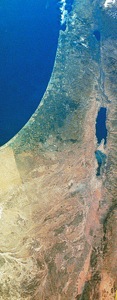Difference between revisions of "Palestine"
m (Text replacement - "http://" to "https://") |
|||
| (3 intermediate revisions by one other user not shown) | |||
| Line 1: | Line 1: | ||
| − | [[Image:lighterstill.jpg]] | + | [[Image:lighterstill.jpg]][[File:Satellite_image_of_Palestine.jpg|right|frame]] |
| − | [[ | ||
| − | Palestine ( | + | Palestine (Arabic: فلسطين Filasṭīn, Falasṭīn, Filisṭīn; Greek: Παλαιστίνη, Palaistinē; Latin: Palaestina; Hebrew: פלשתינה Palestina) is a geographic region in Western Asia between the [[Mediterranean Sea]] and the [https://en.wikipedia.org/wiki/Jordan_River Jordan River]. It is sometimes considered to include adjoining territories. The name was used by Ancient Greek writers, and was later used for the Roman province [https://en.wikipedia.org/wiki/Syria_Palaestina Syria Palaestina], the Byzantine [https://en.wikipedia.org/wiki/Palaestina_Prima Palaestina Prima] and the Umayyad and Abbasid province of [https://en.wikipedia.org/wiki/Jund_Filastin Jund Filastin]. The region is also known as the [https://en.wikipedia.org/wiki/Land_of_Israel Land of Israel] (Hebrew: ארץ־ישראל Eretz-Yisra'el),[1] the Holy Land, the Southern Levant, Cisjordan, and historically has been known by other names including Canaan, Southern Syria and Jerusalem. |
| − | + | Situated at a strategic location between [https://en.wikipedia.org/wiki/Egypt Egypt], [https://en.wikipedia.org/wiki/Syria Syria] and [https://en.wikipedia.org/wiki/Arabia Arabia], and the birthplace of [[Judaism]] and [[Christianity]], the region has a long and [[tumultuous]] [[history]] as a [[crossroads]] for [[religion]], [[culture]], commerce, and [[politics]]. The region has been controlled by numerous different peoples, including [https://en.wikipedia.org/wiki/Ancient_Egyptians Ancient Egyptians], [https://en.wikipedia.org/wiki/Canaan Canaanites], [https://en.wikipedia.org/wiki/Israelites Israelites], [https://en.wikipedia.org/wiki/Assyrians Assyrians], [https://en.wikipedia.org/wiki/Babylonians Babylonians], [https://en.wikipedia.org/wiki/Achaemenid_Empire Persians], [https://en.wikipedia.org/wiki/Ancient_Greeks Ancient Greeks], [https://en.wikipedia.org/wiki/Ancient_Rome Romans], [https://en.wikipedia.org/wiki/Byzantine_Empire Byzantines], the Sunni [https://en.wikipedia.org/wiki/Arab_Caliphate Arab Caliphates], the Shia [https://en.wikipedia.org/wiki/Fatimid_Caliphate Fatimid Caliphate], Crusaders, [https://en.wikipedia.org/wiki/Ayyubids Ayyubids], [https://en.wikipedia.org/wiki/Mameluks Mameluks], [https://en.wikipedia.org/wiki/Ottomans Ottomans], the British and modern Israelis and Palestinians. | |
| − | + | [[Boundaries]] of the region have changed throughout [[history]], and were last defined in modern times by the [https://en.wikipedia.org/wiki/Franco-British_boundary_agreement_(1920) Franco-British boundary agreement] (1920) and the Transjordan memorandum of 16 September 1922, during the mandate period.[3] Today, the region comprises the State of Israel and Palestinian territories in which the [https://en.wikipedia.org/wiki/State_of_Palestine State of Palestine] was declared.[https://en.wikipedia.org/wiki/Palestine] | |
| − | + | ==See also== | |
| − | [[Category: | + | *'''''[[Israel]]''''' |
| + | [[Category: Geography]] | ||
| + | [[Category: History]] | ||
Latest revision as of 01:21, 13 December 2020
Palestine (Arabic: فلسطين Filasṭīn, Falasṭīn, Filisṭīn; Greek: Παλαιστίνη, Palaistinē; Latin: Palaestina; Hebrew: פלשתינה Palestina) is a geographic region in Western Asia between the Mediterranean Sea and the Jordan River. It is sometimes considered to include adjoining territories. The name was used by Ancient Greek writers, and was later used for the Roman province Syria Palaestina, the Byzantine Palaestina Prima and the Umayyad and Abbasid province of Jund Filastin. The region is also known as the Land of Israel (Hebrew: ארץ־ישראל Eretz-Yisra'el),[1] the Holy Land, the Southern Levant, Cisjordan, and historically has been known by other names including Canaan, Southern Syria and Jerusalem.
Situated at a strategic location between Egypt, Syria and Arabia, and the birthplace of Judaism and Christianity, the region has a long and tumultuous history as a crossroads for religion, culture, commerce, and politics. The region has been controlled by numerous different peoples, including Ancient Egyptians, Canaanites, Israelites, Assyrians, Babylonians, Persians, Ancient Greeks, Romans, Byzantines, the Sunni Arab Caliphates, the Shia Fatimid Caliphate, Crusaders, Ayyubids, Mameluks, Ottomans, the British and modern Israelis and Palestinians.
Boundaries of the region have changed throughout history, and were last defined in modern times by the Franco-British boundary agreement (1920) and the Transjordan memorandum of 16 September 1922, during the mandate period.[3] Today, the region comprises the State of Israel and Palestinian territories in which the State of Palestine was declared.[1]
